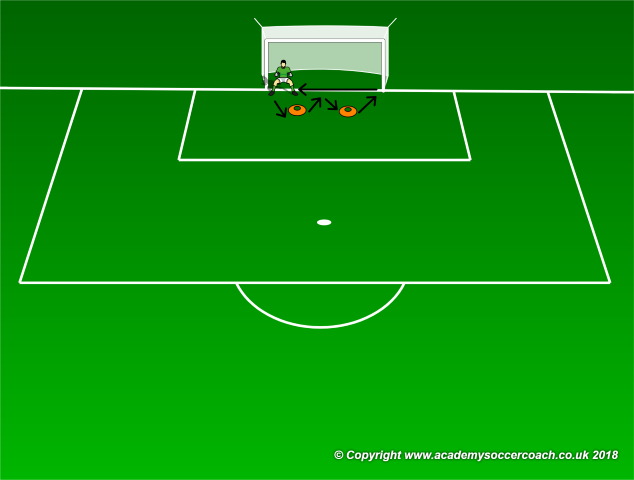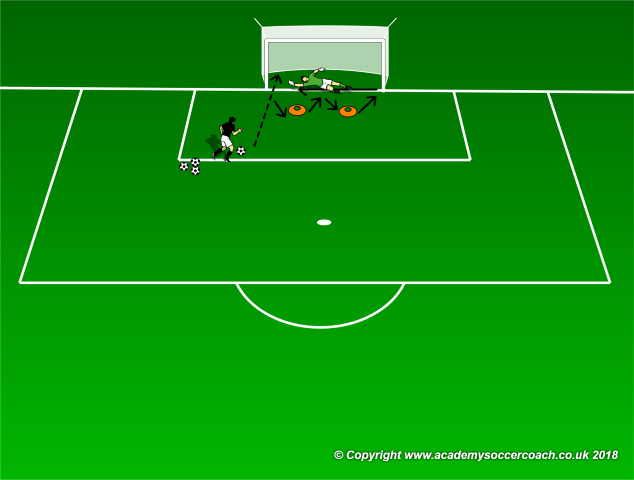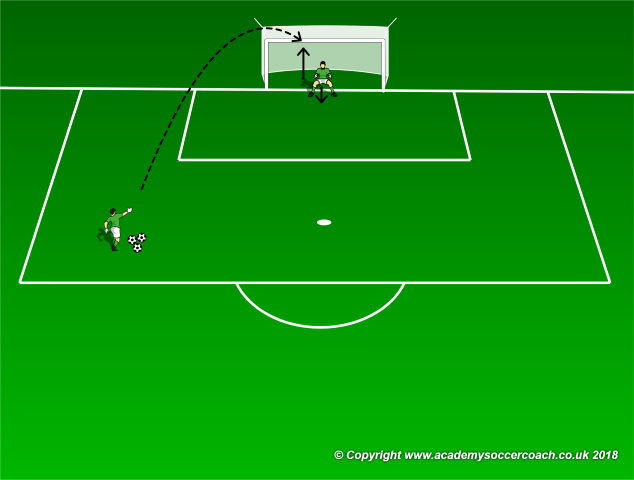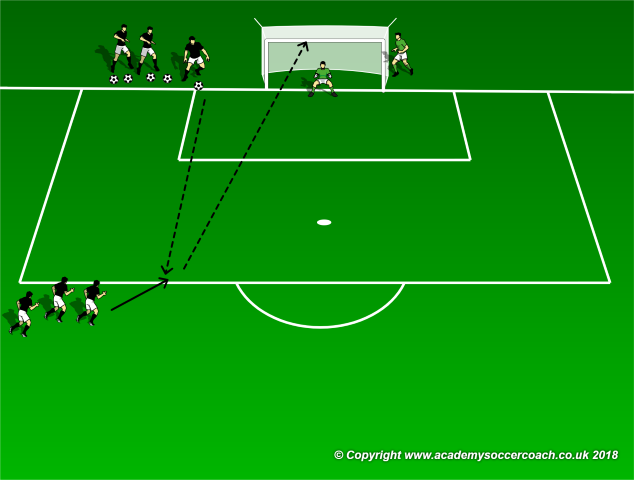By Mike Smith -
"If you can touch the bar you can stop the high shots." I say it, my old coaches all said it, I'm sure their coaches all said it and there are perhaps few truer words ever spoken about goal keeping. However, theory and practice are often two different worlds and I have found many keepers, especially young ones, struggle with stopping higher shots even though most can actually jump up and touch the bar. The good news is, aside from the decision to catch, punch or parry, the real issue with being able to stop the higher shots with consistency is that of body position and timing and I use a drill progression which focuses on both ( body position and timing ) to vastly improve my keepers work in the air.
Set Up

After the keeper has warmed up, place two cones in front of the goal as shown above and focus on the movement shown by the arrows, with a couple of additions. The activity starts with the keeper positioned on one post, with their knees bent - I call this coiled up and this is the first point of instruction to hit in order to see immediate improvement. Many young keepers feel if they stay coiled up, because they are farther from the bar than they would be when standing that they are in a worse position to face high shots. In the age of cell phone video, it is easy to show these keepers that in fact, before they jump, they actually coil up first - i.e. they actually make their first move away from the ball. They quickly realize it makes sense to go ahead and coil up for the jump a bit early ( which also puts them in better position for the low shots as well). In my opinion a keeper should always have a bend in their knees and be coiled up ready to go.
From the bent knee position, the keeper slaps the ground between their legs, springs up to slap the bar with the back of their hands then shuffles up to the cone and back to the center where they repeat the ground and bar slaps. They do this once more to the second cone and after the final slaps near the post, shuffle back to the starting position.
Progression
As shown below, after the keeper ( or keepers ) have done 10 or 12 good rounds of the slaps, add a shooter ( the coach can do this ) who hits a low shot as the keepers are coming back ( as shown ). Yes, I did say low in a drill working on stopping high balls. The idea is to get the keepers focused on staying coiled and low as this is the path to better timing on their jumps. After another 10 or 12 rounds with a shot, they are ready to face some higher balls.

Set Up
Next, have the keepers work together ( a coach can be used if your team only has one keeper ) to throw in high balls on different tracks. First some arcing lobs and then a progression to some driven in with a bit of force straight at the bar. Note the arrows on the keeper in the goal. The idea here is to have the keeper actually touch the ground with the tips of their fingers before making their jump but after the shot is struck ( thrown). Starting with lobs allows the coach to point out that the keeper should be traveling opposite of the ball, and the finger touch shows them they have time on most shots to get themselves positioned for the save. The keeper should be going up as the ball begins to come down thus, they shouldn't jump until the ball is just past its highest point. The most common mistake keepers make on high shots is jumping too early. Making them touch the ground first will help them understand every aspect of timing and body position.

Progression
Finally the fun stuff; after the keeper is consistently coiling up and timing their jumps well, let the shooters come and swing for the fences.
*Side note*- I doubt there is one aspect of soccer which is worked on more by players before and after practice than hitting long shots outside the box. With the amount of time I see young people spending working on long shots I feel like 50 percent of the goals scored in soccer should come from 25 yds or more away and enter the goal above the 7ft mark, but alas, the practice just doesn't seem to make it to the pitch. Clearly I am trying to be humorous and as a coach who prefers the low accurate driven shot I don't spend a lot of time working on high shots unless it is focused on the keeper and perhaps this is why my players love this drill. (Besides, they get enough practice on long shots on their own before and after every practice.)
Set up as shown below with the servers sending the ball to the top of the box and the shooters taking a set up touch and then a high shot. I actually challenge the shooters to hit the ball at the keepers head level and then when they sail it a bit the trajectory always seems right. If the shooters need a bit of warming up do a bit of instruction on accurate high shots, including chips and lobs, and remind them to back off the power a bit until they are dialed in. The coach should help the keeper remember to coil up, get set (time the jump ) , and then either catch it, punch it or parry it away. A few sessions like this and your keeper will be much more confident dealing with the high stuff.

By Mike Smith
Currently the Head Coach for University Heights Academy Boys Soccer in Hopkinsville, KY , Mike is in his 14th year as a high school head coach with 23 years coaching experience overall and 34 year as a student and fan of the game. He holds a USSF D License.


